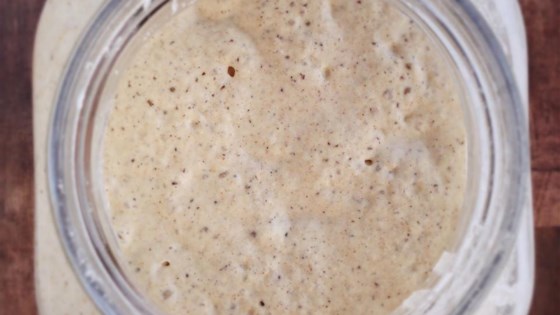Gluten-Free Sourdough Starter The Best Recipes
Looking for recipes Gluten-Free Sourdough Starter, each of our site provides recipes Gluten-Free Sourdough Starter that an individual need Listed below are the quality recipes Gluten-Free Sourdough Starter that will you need
 |
| Gluten-Free Sourdough Starter |
"This is a step-by-step guide on how to begin a gluten-free sourdough starter without yeast. The amounts here are for getting the mother dough started. You will need to keep extra flour mix on-hand to continue feeding as long as you want to keep the starter. Once it begins to have a sponge-like consistency, it is ready to use and should be kept in the fridge or else it will grow wild all over the counter. Add a bit of the starter in your favorite recipes calling for yeast or baking powder for a unique flavor and texture."
Ingredients :
- 3 cups brown rice flour, divided
- 3 cups buckwheat flour, divided
- filtered water, at room temperature, as needed
Instructions :
| Prep : 10M | Cook : 1M | Ready in : P4D |
|---|
- Mix together the brown rice flour and the buckwheat flour until well combined.
- Day 1: Whisk together 1 cup of the flour mix and 3/4 cup filtered water in a glass jar. Stir well until smooth and no lumps remain. Cover with a piece of cheesecloth or a clean linen towel and let sit at room temperature (about 70 degrees F (21 degrees C)), far from drafts or direct sunlight. Do not cover with plastic wrap, the circulation of air is important. Every once in a while, stir the mixture with a fork or whisk. Check to see if small bubbles start to form in the mixture. These bubbles indicate that wild yeast is forming.
- Day 2: As well as stirring, you will begin to feed the starter on day 2. In the morning, mix 1/4 cup of flour mixture and 3 tablespoons room-temperature filtered water. Once mixed well, add the flour-water mixture to the jar with the starter mixture. Stir well and continue to stir throughout the day if possible. Every 12 hours, add this same feeding mixture (1/4 cup flour plus 3 tablespoons water) to the mother mixture.
- Day 3: By now, you should notice an overall sponge-like texture. If this is the case, your starter is ready to use. At this point, it should be kept in certain conditions to keep from over-growing. Keep it sealed, in the refrigerator.
- If your starter has only a bit of foam at the top, but you notice a fragrant smell of yeast, these are good signs and could be that the room is too cool. Check to make sure the location is draft free. If you don't notice these minimal signs and a note a foul smell, discard starter and restart.
- If your sponge is still very watery but has a sponge forming, mix well, take out 1 cup of the mixture, and discard (or use in another recipe) and feed the starter every 6 hours.
- By day 4 your starter should be ready. Keep the starter covered in the refrigerator and feed very two weeks or each time you measure out any starter.
Notes :
- When not being used, your starter will need to be maintained. To feed: allow the starter to reach room temperature. Take out 1/2 cup of starter (use in a recipe, freeze, or discard) and add 1/2 cup of flour mix combined with 1/3 cup of water. Allow the starter to reach room temperature and allow to rest until the starter has begun to foam and bubble. Cover and put back in the fridge.
- Every time you use your starter, add back the same amount that you use. For example, if you use 1/2 cup for a recipe, add 1/2 cup of mixture to replace the same amount.
- Using brown rice flour alone will result in a weak yeast. Teff, quinoa, and sorghum flours are very nice and add unique flavors to the final starter. Tap water contains chlorine and can kill off the wild yeast. For this reason, it is best to use filtered water.
Thanks to visiting our blog. may forget to bookmark each of our site, if our web site provides the best quality recipes.

0 Response to "Gluten-Free Sourdough Starter The Best Recipes"
Post a Comment